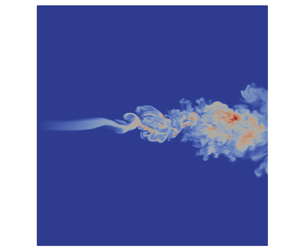Article contents
Analysis of turbulent coagulation in a jet with discretised population balance and DNS
Published online by Cambridge University Press: 28 February 2022
Abstract

The objective of the present study is to investigate turbulence–coagulation interaction via direct numerical simulation (DNS) coupled with the population balance equation (PBE). Coagulation is an important process in several environmental and engineering applications involving turbulent flow, including soot formation, gas-phase synthesis of nanoparticles and atmospheric processes, but its interaction with turbulence is not yet fully understood. Particle dynamics can be described by the PBE, whose Reynolds decomposition leads to unclosed terms involving correlations of number density fluctuations. In this work, we employ a discretisation (sectional) method for the solution of the PBE, which is free of a priori assumptions regarding the particle size distribution (PSD), and couple it with a DNS for the flow field in order to study the behaviour and significance of the unknown correlations. At present, it is not feasible to resolve the Batchelor scales that result from diffusion at high Schmidt number, hence a unity Schmidt number is employed. The investigation is conducted on a three-dimensional planar jet laden with monodisperse nanoparticles, and coagulation in the free-molecule regime is considered. The correlations due to turbulent fluctuations of the particle number density are calculated at several points in the domain and found to be positive in most cases, except close to the jet break-up. The transport equation for the moments of the PSD is also studied, and it is found that the correlations make a considerable contribution to the time-averaged coagulation source term, up to  $20\,\%$ on the jet centreline and
$20\,\%$ on the jet centreline and  $40\,\%$ close to the edges.
$40\,\%$ close to the edges.
- Type
- JFM Papers
- Information
- Copyright
- © The Author(s), 2022. Published by Cambridge University Press
References
REFERENCES
- 10
- Cited by



